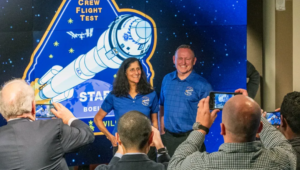In a remarkable turn of events, NASA astronauts Sunita Williams and Barry “Butch” Wilmore have safely returned to Earth after an unexpected nine-month mission aboard the International Space Station (ISS). Originally scheduled for an eight-day mission, the duo’s stay was prolonged due to technical issues with their return spacecraft, leading to an extended and unplanned tenure in space.
The Unexpected Extension
Williams and Wilmore launched to the ISS on June 5, 2024, aboard Boeing’s Starliner spacecraft, with the mission initially set for just over a week. However, shortly after docking, engineers identified critical issues with the Starliner, including helium leaks and malfunctioning thrusters, rendering it unsafe for the return journey. These complications necessitated an immediate reassessment of their return plans, resulting in the astronauts remaining aboard the ISS for an extended period.
Life Aboard the ISS
During their prolonged stay, Williams and Wilmore seamlessly integrated into the ISS crew, contributing to various scientific experiments, maintenance tasks, and even participating in spacewalks. Their extensive experience as veteran astronauts proved invaluable, ensuring the continued success of the station’s numerous missions despite the unforeseen circumstances.
The Rescue Mission
Given the severity of the Starliner’s issues, NASA, in collaboration with SpaceX, devised a plan to bring the astronauts home safely. The strategy involved utilizing SpaceX’s Crew Dragon spacecraft, which had been successfully ferrying astronauts to and from the ISS in recent years. This decision underscored the flexibility and resilience of current spaceflight operations, allowing agencies to adapt to unexpected challenges effectively.
The Journey Home
On March 18, 2025, after more than nine months in space, Williams and Wilmore, along with fellow astronauts Nick Hague and Alexander Gorbunov, who had completed a standard six-month mission, boarded the Crew Dragon spacecraft, aptly named “Freedom.” The spacecraft undocked from the ISS at 6:05 AM CET, initiating their journey back to Earth. The re-entry and descent proceeded smoothly, culminating in a successful splashdown off the coast of Florida at 10:57 PM CET.
First Moments Back on Earth
Upon landing, recovery teams swiftly approached the spacecraft to assist the astronauts. Initial images captured Williams and Wilmore smiling and giving thumbs up, a testament to their resilience and the success of the mission. Medical personnel conducted preliminary health assessments on-site, and all four astronauts appeared to be in good spirits and excellent health, considering the extended duration of their mission.
Reflections on the Extended Mission
The unexpected extension of Williams and Wilmore’s mission has been a topic of significant discussion within the space community. Their ability to adapt to the prolonged stay highlights the rigorous training and mental fortitude required of astronauts. Moreover, this incident has shed light on the inherent risks and uncertainties of space travel, emphasizing the need for robust contingency plans and the importance of international collaboration in addressing unforeseen challenges.
Looking Ahead
With the astronauts safely back on Earth, NASA and its partners will conduct thorough debriefings to glean insights from this mission. These learnings will be instrumental in refining future protocols, spacecraft designs, and mission planning to enhance the safety and efficiency of subsequent space endeavors.
In conclusion, the safe return of Sunita Williams and Barry Wilmore serves as a testament to human resilience, the spirit of exploration, and the collaborative efforts that continue to push the boundaries of what is possible in space exploration.



